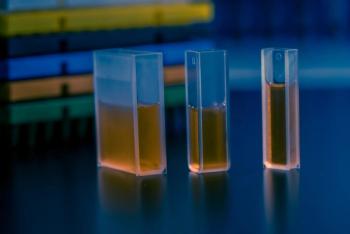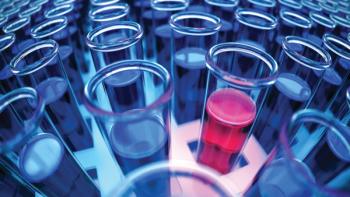
- Pharmaceutical Technology-05-02-2019
- Volume 43
- Issue 5
Testing for Water in DMSO: Exploring Alternatives to Volumetric Karl Fischer Analysis
In Karl Fischer analysis, sulfur trioxide can react with DMSO, invalidating test results. The authors evaluated different instruments and methods, described in this article, to minimize the impact on results.
Peer-Reviewed
Submitted: Dec. 11, 2018.
Accepted: Jan. 23, 2019.
Abstract
Karl Fischer (KF) analysis is a fast and effective way to determine the water content in many excipients and APIs. Dimethyl sulfoxide (DMSO) is a hygroscopic pharmaceutical ingredient. For many years, its water content has been tested using the volumetric KF method, even though the accuracy of results using this method can be affected by reaction between the KF reagent and the DMSO analyte.
In 2018, pharmaceutical companies petitioned the European Pharmacopoeia to change the DSMO testing monograph, which prompted the authors to compare different methods and instruments for this application.
Spiking experiments that assessed water recovery were used to evaluate the interference for several reagent and technique combinations. Finally, method linearity, precision, and accuracy were assessed for each reagent and technique. This work resulted in developing a new technique and analytical instrumentation that would produce water standards in DMSO that were suitable for method development.
In Karl Fischer analysis, sulfur trioxide can react with DMSO, invalidating test results. The authors evaluated different instruments and methods, described in this article, to minimize the impact on results.
The use of United States Pharmacopeia and European Pharmacopoeia (USP and Ph Eur)-grade dimethyl sulfoxide (DMSO) has become increasingly common in topical and parenteral drug delivery systems as a way to make APIs more soluble. A wide variety of applications are currently on the market with multiple routes of administration (1,2). Some of its other applications include acting as a reaction solvent for the synthesis of APIs and intermediates as well as use as an API itself.
The US and European compendial methods both specify that volumetric Karl Fischer (KF) be used for water determination in DMSO (3,4). Unfortunately, there are many drawbacks to using volumetric KF with DMSO. For one thing, an intermediate product, sulfur trioxide, reacts with DMSO in the presence of iodide. This redox reaction reduces DMSO to dimethyl sulfide (DMS), generating iodine in the process. This iodine then titrates water in the sample, which results in low recovery. This particular interference has been observed by a number of device manufacturers and has been further discussed in technical papers (5,6). Some manufacturers have also observed the same interference when using coulometric KF (7).
Other issues have also become apparent when analyzing anhydrous DMSO samples. Due to the hygroscopic nature of DMSO, exposure to environmental moisture results in an uptake of water. This interference can lead to skewed results when calculating the recovery factor that is necessary for volumetric KF. The burette for volumetric KF is designed to titrate samples with a water content greater than 1% w/w. Device manufacturers for volumetric KF suggest that 10–90% of the burette volume be used for optimal usage. For anhydrous DMSO samples, the amount of burette volume used can be as low as 0.3%, leading to accuracy and precision errors.
Approach
Each analytical method was evaluated over a wide range of concentrations. Because of the extremely hygroscopic nature of DMSO, special techniques were developed to prepare and handle DMSO standards that contained less than 50 ppm water.
Septum-lined sample bottles were used to allow for the addition of water spikes and subsequent withdrawal of material without having to remove the container cap. Activated molecular sieves (8) were then used to dry down the DMSO samples to help achieve a lower initial water content.Once dried, the DMSO was transferred to a thoroughly dried sample bottle. To prevent exposure to environmental moisture during transfer, an apparatus was set up to transfer the dry material. It consisted of a stainless-steel cannula and a nitrogen purge, as shown in Figure 1. All water and stock spikes were prepared using a gas-tight syringe (9) in the same bottle to control the risk of environmental moisture associated with transferring the dry DMSO into multiple bottles. A 1% w/w water stock solution was also used to control the error inherent to weighing small volumes of water.
To perform recovery calculations, an initial water assay of the DMSO sample was required. This calculation was accomplished using the method of standard addition (10).
The volumetric KF method (11) was then assessed using data from validation exercises that had been performed in 2016 and 2018. Low recovery was exhibited in both validations but could be corrected with the use of a recovery factor. Tests were run using different commercially available Karl Fischer reagents (12) and results were compared. These experiments showed that the use of methanol-based reagents improved both accuracy and precision.
In a pharmaceutical environment wherein accurate water measurements are needed as a means of process control, it is beneficial to be able to make multiple injections without having to change out the solution. An experiment was carried out in which numerous injections of DMSO were made into a titration vessel without emptying the titration cell and filling with fresh solution. When comparing the cumulative volume of DMSO in the titration vessel against water concentration values returned by the instrument, two trends became apparent: A downward trend in the results was seen when using higher concentration material (Figure 2B) and an upward trend for lower concentration material (Figure 2A).
The method works relatively well for DMSO that contains higher concentrations of water. However, using a recovery factor is not sufficient when using KF analysis on extremely dry product samples. The authors had considered using a Karl Fischer oven module to assess water in DMSO samples, while preventing DMSO from entering the titration cell. Instrument manufacturers suggested, instead, that using an oven would result in the same problems, so the decision was made to consider using a gas chromatograph (GC) equipped with a thermal conductivity detector (GC-TCD) and an ionic liquid-based GC column (13, 14, and 15) as an alternative to volumetric KF.
A GC-based method offered an attractive alternative to a KF titrator for several reasons. First, if it worked, the GC-TCD analysis would avoid the complicated interferences observed between DMSO and components of the KF reagent. In addition, a GC is generally a more robust instrument than a KF titrator. It requires less maintenance and fewer consumables and can be used to analyze for more than one impurity at a time. GC analysis is also less technique dependent, making it ideal for in-process testing.
The authors found that the GC-TCD method worked relatively well at higher water concentrations, as shown in Table I. At concentrations lower than 300 ppm, however, the GC-TCD signal was not intense enough to generate the area counts that were required to reproduce data precisely, which led to linearity problems. However, percent recovery values were deemed suitable across the testing range, based on an assessment of triplicate injections. Using fewer injections resulted in low precision at concentrations less than 300 ppm, causing recovery to vary widely. However, the need for triplicate injections resulted in a significant runtime for each sample analysis.
The authors then considered the coulometric KF (15) method for this application, especially after learning that the approach had been mentioned in a 2018 petition to the Ph Eurto change the DMSO testing monograph. Spiking experiments (16) were used to assess the method’s capabilities (17).
Excellent recovery and precision were observed, even for concentrations as low as 35 ppm up to around 100 ppm, without the use of a recovery factor. They were also seen for concentrations of up to 1000 ppm with the use of a recovery factor ( shown in Tables II and III). Manufacturer reviews suggested that a side reaction would occur, but using the recovery factor prevented this problem from taking place. However, coulometric KF does not seem to have the same precision issues that volumetric KF has at lower concentrations.
When numerous injections of DMSO were made into the titration vessel without emptying the titration cell and filling it with fresh solution, there were no significant differences in the results (Figures 2C–D). This was observed at both low and high concentrations. It seems that the DMSO/KF reagent interference has no effect on the trend in results after numerous injections for coulometric KF. In fact, the only potential downside of using coulometric KF is that it is not designed to titrate greater than 1 % w/w water. For DMSO samples with a water content greater than 1% w/w, volumetric KF can instead be used with a recovery factor. When a recovery factor is used at a concentration > 1 % w/w, results show a high degree of accuracy and precision.
Conclusion
Of the three methods that were evaluated for water determination in DMSO, the coulometric KF method proved to be the most effective at analyzing samples that contained less than 1% w/w water. Even though the DMSO/KF reagent interference is still present, improved recovery, precision, and a significantly lower limit of quantitation is observed when a recovery factor is applied. Its short run time, as well as the ability to support numerous injections of DMSO without significant differences in results, makes this method ideal for in-process testing.
Volumetric KF and GC-TCD are both suitable methods for DMSO samples that contain a water concentration greater than 1% w/w. A recovery factor should be applied when using volumetric KF due to the DMSO/KF reagent interference. Making numerous DMSO injections into a volumetric KF titration vessel is not recommended due to a decrease in recovery at high concentrations and an increase at low concentrations. In addition, the need for triplicate injections when using the GC-TCD method causes an increase in run time and makes it less ideal for in-process testing.
References
1. A.S. McKim and R.T. Strub, Pharm. Tech. 2016 Supplement (3), 30-35 (2016).
2. A.S. McKim and R.T. Strub, Pharm. Tech. 32 (5) 74-85 (2008).
3. USP, USP 40-NF35, p. 3792 (US Pharmacopeial Convention, Rockville, MD, 2017).
4. EDQM, EurPh, 9.0 Volume 2 (EDQM, Strasbourg, France, 2017), p. 2280.
5. W. Fischer, S. Beil, D. Krenn, Journal für praktische Chemie 337(1), 266-268 (1995).
6. Metrohm, Application Work AW KF DE5-0377-072012: Dimethyl Sulfoxide as Solubilizer in KF Titration (2011).
7. Hydranal, Laboratory Report L 141: Water Determination in Dimethyl Sulfoxide (2017).
8. 3Å molecular sieves were used (Catalog # 208574-5KG). The DMSO stood over the molecular sieves for >72 hours.
9. Gas-Tight Syringe: 2.5 mL Hamilton #1002 PTFE Luer Lock
10. J. M. Miller and J. B. Crowther, Analytical Chemistry in a GMP Environment: A Practical Guide,pp.390-391 (Wiley, New York, NY, 2000).
11. E. Scholz, “Titration Techniques,” in Karl Fischer Titration: Determination of Water (Springer-Verlag, New York, NY, 1984), pp. 15-19.
12. Comparison of KF reagents: Hydranal KetoSolver (Catalog # 34738) and Hydranal Composite 2 (Catalog # 34806); Aquastar Solvent KN (Catalog # AX-1699EN-6) and Aquastar Composite 2 (Catalog # AX1698B-5); Aquastar CombiMethanol (Catalog # M1880092545) and Aquastar CombiTitrant 2 (Catalog # M1880022545)
13. Y. Zhang, et al., LCGC Europe24 (10), 516-529 (2011).
14. J. M. Miller and J. B. Crowther, Analytical Chemistry in a GMP Environment: A Practical Guide(Wiley, New York, NY, 2000), pp.236-240.
15. Watercol 1900 Capillary Column 30m x 0.25mm x 0.2µm film thickness (Catalog # C21615010)
16. E. Scholz, “Coulometric Determination,” in Karl Fischer Titration: Determination of Water(Springer-Verlag, New York, NY, 1984), pp. 19-21.
17. Coulometric Titrator: Mettler Toledo C20X (Catalog # 51105512); Coulometric Reagent: Aquastar CombiCoulomat Fritless (Catalog # 1092570500)
Article Details
Pharmaceutical Technology
Volume 43, Number 5
May 2019
Pages: 44–48
Citation
When referring to this article, please cite it as A. Johnson and A. Jones, "Testing for Water in DMSO: Exploring Alternatives to Volumetric Karl Fischer Analysis," Pharmaceutical Technology 43 (5) 2019.
About the Authors
Andrew Johnson is analytical specialist, ajohnson@gaylord.com and Ashley Jones is analytical chemist, ajones@gaylord.com both with Gaylord Chemical Co, LLC.
Articles in this issue
over 6 years ago
Closed Systems for Aseptic Fill and Finishover 6 years ago
Contract Packaging Growsover 6 years ago
New Kit Identifies Endonuclease Impuritiesover 6 years ago
New Pneumatic Pressesover 6 years ago
New Size for AODD Pumpover 6 years ago
1000-Gallon Pivoting Triple Shaft Mixerover 6 years ago
Bioprocessing Facilities and FDA Inspection Problemsover 6 years ago
FDA Faces Challenges After Gottliebover 6 years ago
The Auditor Vs. Inspector Issueover 6 years ago
Avoiding Excipient VariabilityNewsletter
Get the essential updates shaping the future of pharma manufacturing and compliance—subscribe today to Pharmaceutical Technology and never miss a breakthrough.




